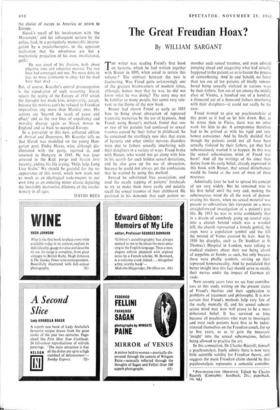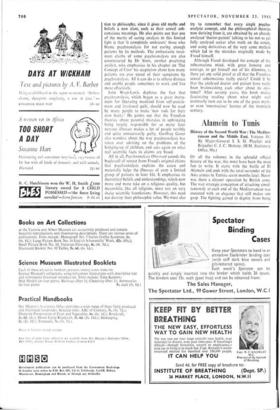The Great Freudian Hoax?
By WILLIAM SARGANT
THE writer was reading Freud's first book on hysteria, which he had written together with Breuer in 1895, when asked to review this volume.* The contrast between the two is fascinating. Was Freud quite unknowingly one of the greatest brainwashers of modern times, although, honest man that he was, he did not know what he was doing? The story may not be familiar to many people, but seems very rele- vant to the theme of the new book.
Breuer had shown Freud as early as 1883 how to bring about abreaction of repressed traumatic memories by the use of hypnosis. And Freud, using Breuer's method, found that one or two of his patients had confessed to sexual traumas caused by their father in childhood. So he conceived the startlingly new idea that states of hysteria and other similar nervous disorders were due to fathers sexually interfering with their daughters in a variety of ways. Freud broke with Breuer, who would not go along with him in his search for such hidden sexual deviations, and he also gave up the use of abreaction, because he could not always get the confessions that he wanted by using this method.
Instead he substituted free association, and used the steady tapping of patients' foreheads to try to make them more easily and quickly recall the sexual traumas of their childhood. He persisted in his demands that each patient re-
member such sexual traumas, and even advised jumping ahead and suggesting what had actually happened to the patient, so as to hasten the process of remembering. And lo and behold, no fewer than ten out of ten patients all finally remem-
bered being sexually violated in various ways
by their fathers. Ten out of ten among the middle class of Vienna, a hundred out of a hundred, a thousand out of a thousand fathers interfering with their daughters—it could not really be the case.
Freud wanted to give up psychoanalysis at this point as it had so let him down. But, as
he wrote then to Fleiss, there was no other work for him to do. A compromise therefore had to be arrived at with his rigid and very honest conscience. And he finally decided that though the patients could not all have been actually violated by their fathers, yet they had subconsciously wanted it to happen. In this way the sexual subconscious mind of Freud was born! And all the writings of his since then derive from his early belief, already expressed in this book with Breuer, that sexual disturbances would be found at the root of most of these neuroses.
Admittedly later he had to spread his concept of sex very widely. But he remained true to his first belief until the very end, making the subconscious mind do all the work of demon- strating his theory, when no sexual material was present to substantiate this viewpoint on a more straightforward investigation of a patient's past life. By 1913 he was to write confidently that in a dream of somebody going up several steps into a church behind which was a wooded hill, the church represented a female genital, the steps were a copulation symbol and the hill the mound of Venus covered by hair. And by 1916 his disciples, such as Dr Stoddart at St Thomas's Hospital in London, were talking to medical students about their not being afraid of zeppelins or bombs as such, but only because these were phallic symbols, stirring up their repressed homosexuality. And he postulated that better insight into this fact should serve to steady their nerves under the impact of German air raids.
Now seventy years later we see four contribu- tors to this study writing on the present status of Freud's theories and their application to problems of treatment and philosophy. It is now certain that Freud's methods help very few of the really mentally ill, and his sexual subcon- scious mind may now well prove to be a mass delusional belief. It has survived so long because all psychiatrists who want to investigate and treat such patients have first to be indoc- trinated themselves on the Freudian couch, for up to five years, so as to gain the necessary `insight' into the sexual subconscious, before being allowed to practise the art.
In this connection, Dr Charles Rycroft, himself a psychoanalyst, freely admits there is now very little scientific validity for Freudian theory, and suggests the main Freudian claim should be that psychoanalysis represents a semantic contribu- * PSYCHOANALYSIS OBSERVED. Edited by Charles Rycroft. (Constable : hardback, 21s.; paperback, 10s. 6d.)
tion to philosophy, since it gives old myths and beliefs a new slant, such as their sexual sub- conscious meanings. He also points out that one of the merits of seeing analysis in this limited light is that 'it completely undercuts' those who blame psychoanalysis for not curing enough patients by its methods. The enthusiastic treat- ment claims of some psychoanalysts are also counteracted by Dr Storr, another practising analyst, who emphasises in his chapter on 'The Concept of Cure' his scepticism about how many patients are ever cured of their symptoms by psychoanalysis. All it can do is to relieve distress and enable people sometimes to work and live more effectively.
John Wren-Lewis deplores the fact that psychoanalysis, which began as a great instru- ment for liberating mankind from self-punish- ment and irrational guilt, should now be used by many people to make 'new rods for their own backs.' He points out that the Freudian theories about parental mistakes in upbringing being largely responsible for so many later nervous illnesses makes a lot of people terribly and quite unnecessarily guilty. Geoffrey Gorer also wonders about the way psychoanalysis has taken over advising on the problems of the bringing-up of children, and asks again on what real scientific facts its claims are based.
All in all, Psychoanalysis Observed sounds the bugle-call of retreat from Freud's original claims that psychoanalysis explains the cause and materially helps the illnesses of even a limited group of patients in later life. It emphasises its theoretical beliefs and understandings, which now more and more take on a religious quality, but meanwhile, like all religions, must rest on very shaky scientific foundations. However, this need not destroy their philosophic value. We must also
try to remember that every single psycho- analytic concept, and the philosophical theories now deriving from it, are obtained by an already analysed 'doctor-patient' talking to his not as yet fully analysed seeker after truth on the couch, and using derivatives of the very same method which led to the mistakes originally made by Freud himself.
Although Freud developed the concept of the subconscious mind, with great honesty and courage, to get himself out of his dilemma, is there yet any solid proof at all that the Freudian sexual subconscious really exists? Could it be that the analysed doctor and patient have really been brainwashing each other about its exis- tence? After seventy years, this book makes fascinating reading about what might well eventually turn out to be one of the great myths or even 'unconscious' hoaxes of the twentieth century.















































 Previous page
Previous page